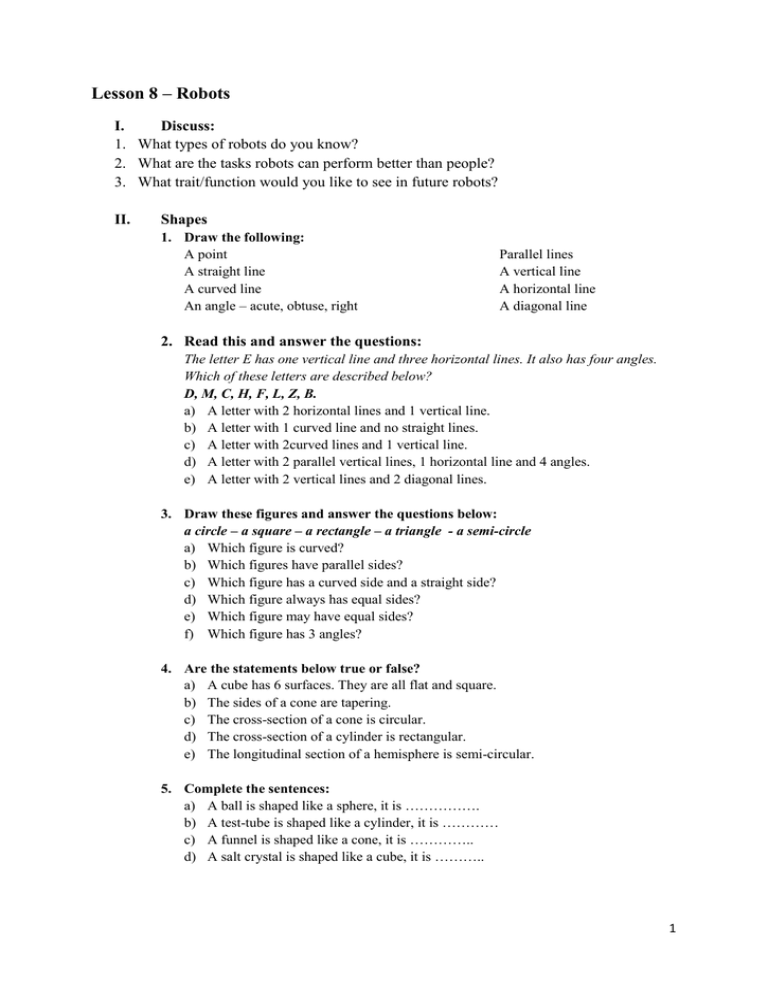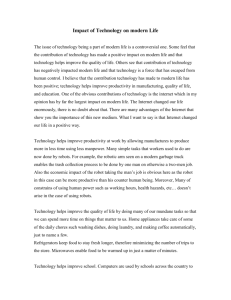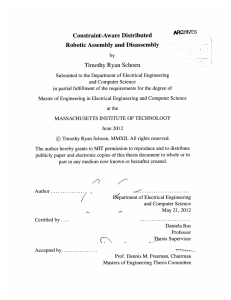A) break down B) carry out C) home in on
advertisement

Lesson 8 – Robots I. Discuss: 1. What types of robots do you know? 2. What are the tasks robots can perform better than people? 3. What trait/function would you like to see in future robots? II. Shapes 1. Draw the following: A point A straight line A curved line An angle – acute, obtuse, right Parallel lines A vertical line A horizontal line A diagonal line 2. Read this and answer the questions: The letter E has one vertical line and three horizontal lines. It also has four angles. Which of these letters are described below? D, M, C, H, F, L, Z, B. a) A letter with 2 horizontal lines and 1 vertical line. b) A letter with 1 curved line and no straight lines. c) A letter with 2curved lines and 1 vertical line. d) A letter with 2 parallel vertical lines, 1 horizontal line and 4 angles. e) A letter with 2 vertical lines and 2 diagonal lines. 3. Draw these figures and answer the questions below: a circle – a square – a rectangle – a triangle - a semi-circle a) Which figure is curved? b) Which figures have parallel sides? c) Which figure has a curved side and a straight side? d) Which figure always has equal sides? e) Which figure may have equal sides? f) Which figure has 3 angles? 4. Are the statements below true or false? a) A cube has 6 surfaces. They are all flat and square. b) The sides of a cone are tapering. c) The cross-section of a cone is circular. d) The cross-section of a cylinder is rectangular. e) The longitudinal section of a hemisphere is semi-circular. 5. Complete the sentences: a) A ball is shaped like a sphere, it is ……………. b) A test-tube is shaped like a cylinder, it is ………… c) A funnel is shaped like a cone, it is ………….. d) A salt crystal is shaped like a cube, it is ……….. 1 III. Describing machines and pieces of equipment Read the definitions of the adjectives listed below. What machines do they make you think of? all-singing, all-dancing an all-singing, all-dancing system or piece of equipment is very advanced and able to do everything you want it to cordless a cordless tool or piece of equipment works without being connected to the electricity supply cranky likely to stop working at any time fail-safe designed to make a machine or piece of equipment stop working if part of it stops operating normally high-performance designed to be very fast or powerful incompatible ideas, systems, or machines that are incompatible are not able to work or exist together because of basic differences inflatable an inflatable object must be filled with air before you can use it labour-saving labour-saving equipment do jobs in a quick and effective way so that you needn´t spend a lot of time doing them yourself low used about equipment that is not producing much energy, or that has not got much energy left portable something that is portable, for example a small computer, television, or other small piece of electrical equipment smart smart machines, especially weapons, use computer technology to make them effective spring-loaded operated by a spring inside submersible a submersible machine or vehicle can work under water two-way able both to send and to receive messages unfriendly not easy to use or operate unmanned used for describing a building or machine that does not have any staff there to manage or operate it. Some people avoid using this word because they consider it offensive to women, and use unstaffed or uncrewed instead unsophisticated used for describing simple tools and pieces of equipment that are not advanced user-friendly a user-friendly system or piece of equipment is easy to use or understand 2 IV. Designing a robot You are the representatives of a team of inventors who devised a new type of robot. In groups, prepare a short presentation describing your prototype. Decide on the following: Name of the robot Form and size Material Use Operating instructions Estimated production cost Market prospects – what is new about your prototype Be prepared to answer questions. Then listen to the other investors´ presentations. You may ask for more details about the other robots. In the end, as a whole class, select one prototype for future production. V. Is artificial intelligence dangerous? http://curiosity.discovery.com/question/artificial-intelligence-dangerous Listen to experts discussing A.I. and summarise their viewpoints. VI. Language focus 1. Expressing wishes or regrets Imagine you are no longer happy with the invention of your robot. Look at the way you might express your regrets and wishes. a) b) c) d) I wish I had never created such a robot. If only I had realised then what a tremendous effect it would have. I wish people stopped using it at once. I wished they wouldn´t manufacture it any more. Which of the sentences above express: regrets about the past, for something that has already taken place a wish for the present a wish for the future Now imagine the situations described below. For each situation make one or more sentences beginning with I wish… or If only… a) You watched a thriller in which alien robots were invading the Earth and you´ve had nightmares ever since. b) The managing director of your company intends to replace 70% of the labourers in the assembly line with a robotic system. c) You have just failed in a difficult exam and you realise you didn´t work hard enough for it. Share with your partner three regrets about your past, referring to the things you did or did not do. 3 2. Back to the future Think of how your life has already changed thanks to technology. Complete the columns with as many examples as you can. Past Present Future E.g. Wrote letters send e-mails ? VII. Phrasal verbs 1. Complete the sentences with suitable particles: 1. 2. 3. 4. 5. 6. 7. 8. When I tried to switch _____ my computer, nothing happened. Would the last person to leave the room please turn _____ the lights. The computer isn´t working because you haven´t plugged it _______! Can you turn _______ the TV – I can hardly hear what the actors are saying. My mobile isn´t working – I need to charge it ________. The alarm went ____ in the middle of the night, waking all the neighbours. The pilot´s radio cut _______ as the plane was flying over the Himalayas. We´ve just bought a breadmaking machine. All you do is measure _____ all the ingredients, put them in the machine and switch it _____. 9. The mechanic pumped ______ the tyres while he was servicing the car. (adapted from McCarthy,M.; O´Dell, F. English Phrasal Verbs in Use. Cambridge University Press, 2004.) 2. For each sentence, choose the best word or phrase to complete the gap from the choices below. 1. Recently, scientists have ___________ that the meteorite which wiped out the dinosaurs might have also resulted in an ice age. A) carried out B) pointed out C) made up 2. By a process of elimination, the computer technician was able to __________ the faulty component in my home PC and soon it was working again. A) break down B) carry out C) home in on 3. Researchers at the University of Bedminster have been ____________ a study to determine the most efficient way to peel a banana. A) pointing out B) carrying out C) figuring out 4. For decades, great minds have tried to __________ what shape the universe is and finally, it seems, someone has come up with an answer. A) point out B) figure out C) carry out 5. Today a network of virus-infected computers which for months has been ____________ billions of Spam e-mails has finally been shut down. A) carrying out B) giving out C) cranking out 6. After this the untreated sewage is placed in fermenting tanks where special bacteria are used to __________ any organic matter and solid material. A) break down B) do away with C) carry out 7. With the recent introduction of electric cars, it is hoped that petrol-driven vehicles can be __________ by the end of the next decade. A) carried out B) given out C) phased out (exercise adapted from www.ihbristol.com/free-english-exercises/test/esol-smc-phrasal-verbs-science) 4





